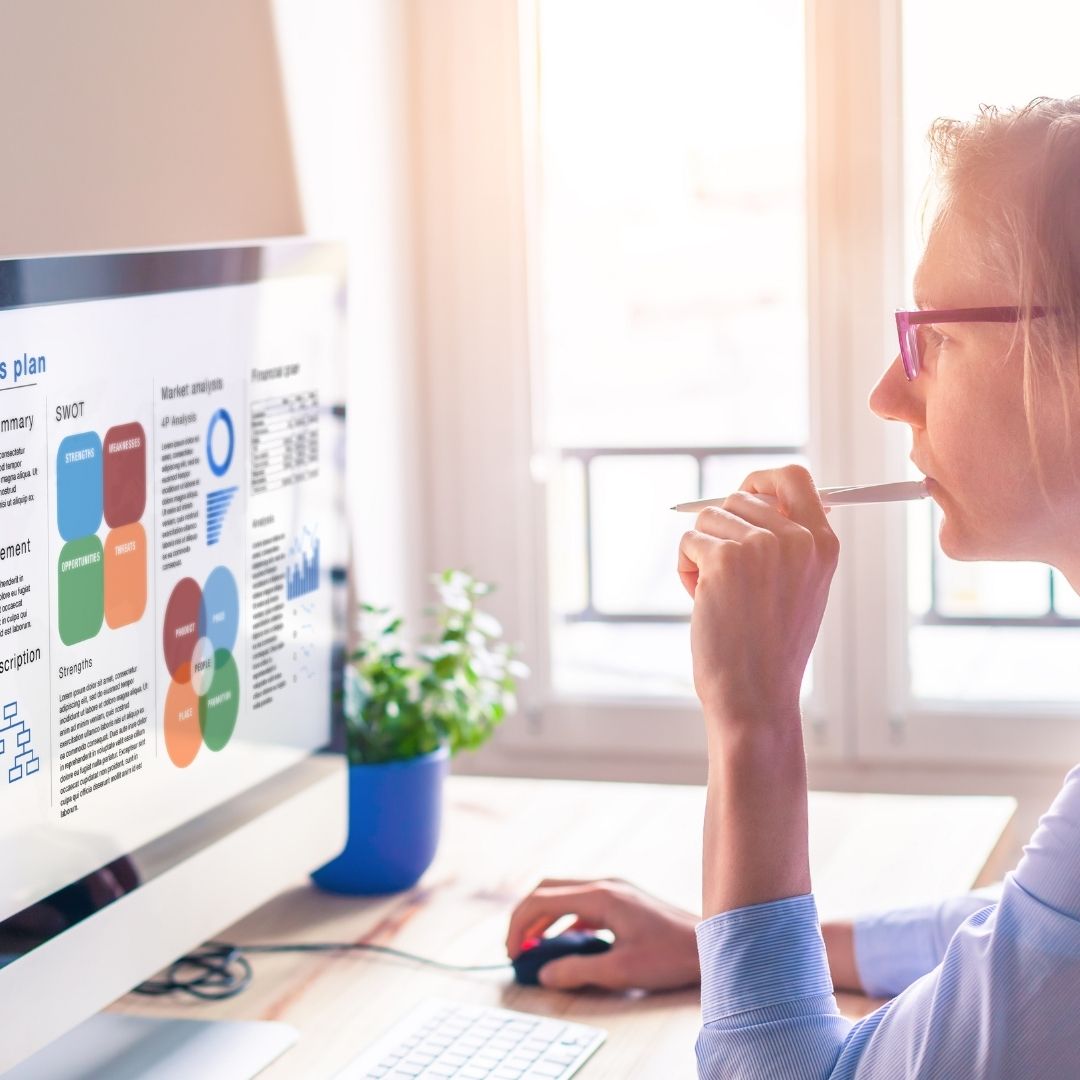More Americans are working from home or transitioning to online schooling than in the past, and the shift in locations means an increase in the time spent in front of a screen.
Outside of work, many of us use social media platforms to stay connected with loved ones. We text, email, and videoconference for communication. We also tend to watch more television or play more video games when social gathering is discouraged. All of these activities involve staring at a lit screen.
Since the start of the pandemic, the world has seen a significant increase in screen-related vision problems in people of all ages [1-3]. Screens are not inherently bad for your eyes, but spending too much time in front of them is [4].
The ocular consequences of too much screen time even have a name: computer vision syndrome (CVS). One study showed a significant increase in computer vision syndrome symptoms after only 6-8 weeks [2].
CVS includes a range of physical problems and symptoms related to the eyes, and research has shown that approx of people who work at a computer express symptoms of CVS [5]. Although “computer” is the only device in the name, tablets, phones, and television screens can elicit the same effects.

How are Screens Bad for Your Eyes?
Computer Vision Syndrome (CVS)
Just like carpal tunnel syndrome can result from repeating small movements over and over, CVS results from repeating tiny eye movements over and over. Reading words on a screen, glancing back and forth between windows, or following motion in a video requires a lot of effort on the part of your eye muscles.
Your eyes also work overtime to change focus quickly when you look away from and back to the screen, such as repeatedly glancing down at printed papers or your keyboard while working. On top of all this, screens flicker, sometimes at a rate faster than our brain can register, and give off a glare, which is not an obstacle when reading from paper.
While it has not been proven that the effects cause permanent damage, CVS symptoms (or screen time overload) are blurred or double vision, dry, red eyes, eye irritation, headaches, and neck or back pain.
Blue Light
Separate from CVS, but adverse nonetheless, are the effects of the blue light from digital screens. Natural light appears white but actually contains red, orange, yellow, green, blue, indigo, and violet light. Every color light has a different energy level and wavelength. Rays on the red end have longer wavelengths and less energy, while blue rays have shorter wavelengths and more energy. LED light that comes off of digital screens is made up of more blue light than other wavelengths.
On one hand, blue light can benefit your productivity as it boosts alertness, helps memory and cognitive function, and elevates mood [6]. Because of this, when exposure comes mainly during the daytime, blue light can help maintain a healthful circadian rhythm or sleep/wake cycle. Unfortunately, few of us turn off screens as soon as the sun goes down. Too much exposure to blue light at night negatively affects the circadian rhythm, leading to sleep difficulties at night and sleepiness during the day [6].
Blue light can reduce image contrast on a screen contributing to digital eye strain, or CVS [6]. Over an extended period of time, studies have shown that blue light likely causes damage to the retina, and therefore contributes to age-related macular degeneration [6]. We should be especially careful about screens and children. Studies have shown that a child’s eye absorbs more blue light energy from a digital screen than an adult’s [7], suggesting the effects may also be more severe.
How to Protect Your Eyes from Screens
When it comes to leisure activities and social media scrolling, we can try to reduce our screen time. Try setting a daily social media screen time limit on your phone as a reminder to put it down. Be reticent of the clock and the effects of blue light at night, and try to limit any screen use after dark to maintain a healthy sleep and wake cycle.
In terms of work, you probably don’t have the option to cut down on screen time. Luckily there are several other steps you can take to support your eye health while working at the computer.
Wear Your Glasses
If you know you have imperfect vision, make sure you are wearing the right prescription for working at the computer. Depending on your individual eyesight, your optometrist may tweak your prescription or suggest adding blue light protective lenses to your glasses. Even if you don’t wear glasses otherwise, you may benefit from wearing protective lenses to reduce blue light exposure.
Treat Dry Eyes
People actually blink less often when staring at screens, which can contribute to eye dryness and irritation [8]. Try to remember to blink more frequently, re-wetting the cornea. Stay hydrated by drinking plenty of water and ask your healthcare professional about eye drops if you notice excessive dryness.
Up Your Antioxidant Intake
Vision and eye health are somewhat dependent on the nutrients we consume. Our eyes are particularly concentrated with blood vessels and nerve tissue and are therefore extra susceptible to oxidative damage that can contribute to macular degeneration as we age. Consider adding some antioxidant support to your diet. Lutein and zeaxanthin, specifically, are the two carotenoids found naturally in the macula with antioxidant properties and have been shown to promote macular health [9]. Foods high in these two antioxidants include dark green leafy vegetables, eggs, peppers and corn.
Adjust the Lighting Around You
Do you notice a glare off of your screen from nearby windows? Is the room dark with your screen acting as the only light source? Both of these factors can contribute to eye strain and related symptoms [4]. Make sure you work in a well-lit space and try an anti-glare screen cover if you cannot cover the window or avoid the sun.
Monitor Position and Quality
For the least amount of eye strain, a computer monitor should be placed so that the center of the screen is six inches below your straight-ahead gaze. Higher resolution LCD monitors with a matte finish are the best choice to prevent eye strain, but if you have an older model monitor, try adjusting the settings to the highest refresh rate to minimize flicker [4].
Let Your Eyes Rest
Try following the 20/20/20 rule: after 20 minutes of working at the computer, look into the distance 20 feet away for 20 seconds and allow your eyes to refocus. The American Optometric Association also suggests that you take a 15-minute break after every 2 hours of continuous computer use [4].
Reduce Blue Light Exposure
Your devices may have a nighttime setting that adjusts the level of blue light emanating from your screen. Some even have a setting to make the switch automatically at certain hours of night and day. Again, reducing your overall screen use is the best method for reducing the damage that may be taking place in response to light exposure.
- Wang, Lixiang, Xin Wei, and Yingping Deng. “Computer Vision Syndrome During SARS-CoV-2 Outbreak in University Students: A Comparison Between Online Courses and Classroom Lectures.” Frontiers in public health 9 (2021).
- Wang, Lixiang, Xin Wei, and Yingping Deng. “Computer Vision Syndrome During SARS-CoV-2 Outbreak in University Students: A Comparison Between Online Courses and Classroom Lectures.” Frontiers in public health 9 (2021).
- Li, Rui, et al. “Prevalence of Self-Reported Symptoms of Computer Vision Syndrome and Associated Risk Factors among School Students in China during the COVID-19 Pandemic.” Ophthalmic Epidemiology (2021): 1-11.
- Barthakur, Rimli. “Computer vision syndrome.” Internet Journal of Medical Update 8.2 (2013): 1-2.
- Hwang, Youjin, et al. “Design Guidelines of a Computer-Based Intervention for Computer Vision Syndrome: Focus Group Study and Real-World Deployment.” Journal of Medical Internet Research 23.3 (2021): e22099.
- Tosini, Gianluca, Ian Ferguson, and Kazuo Tsubota. “Effects of blue light on the circadian system and eye physiology.” Molecular vision 22 (2016): 61.
- O’hagan, J. B., M. Khazova, and L. L. A. Price. “Low-energy light bulbs, computers, tablets and the blue light hazard.” Eye 30.2 (2016): 230-233.
- Seltman, Whitney. “What is Computer Vision Syndrome?” WebMD Medical Reference August 17, 2019. https://www.webmd.com/eye-health/computer-vision-syndrome#1
- AREDS2 Research Group. Lutein/zeaxanthin and omega-3 fatty acids for age-related eye disease study 2 (AREDS2) controlled randomized clinical trial. JAMA. 2013 pub online May 5.
Share:
Related Posts

Goodbye Pie Chart, Hello Phase 1 Sliders
Written by Allison Smith, ND | 2025 As we usher in a new era of DUTCH testing which leaves behind the concept of the three-way

Introducing the DUTCH Dozen
Written by Kelly Ruef, ND | 2025 Hormone testing can be complex, which is why Precision Analytical developed the DUTCH Dozen, an interpretive framework that

DUTCH Report Enhancements
Written by Hilary Miller, ND | 2025 Precision Analytical have released the newest version of the DUTCH Test. This is the report’s most significant update

Gallbladder Health 101: What It Does and How to Keep It Working Well
Written by Ashley Palmer & Pooja Mahtani | 2025 The gallbladder may not get much attention compared to the gut, but it plays a central

Can You Bring Vitamins on a Plane? How To Travel with Supplements
Written by Austin Ruff | 2024 Are you traveling for a work conference, an athletic competition, or a weekend getaway? Just because you’re leaving home

